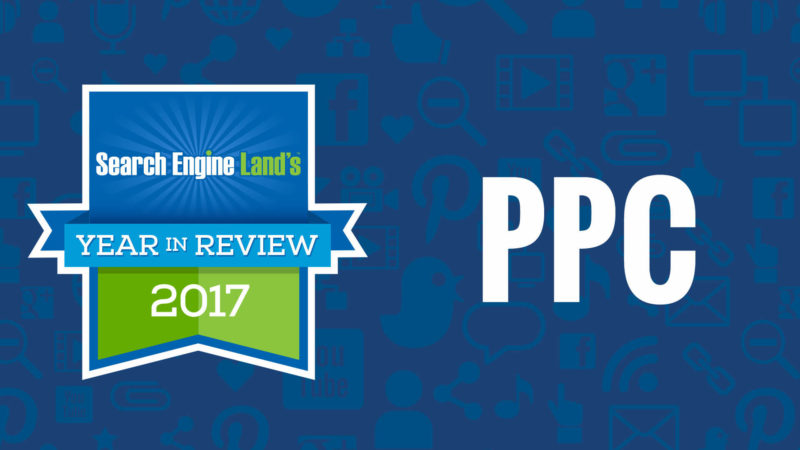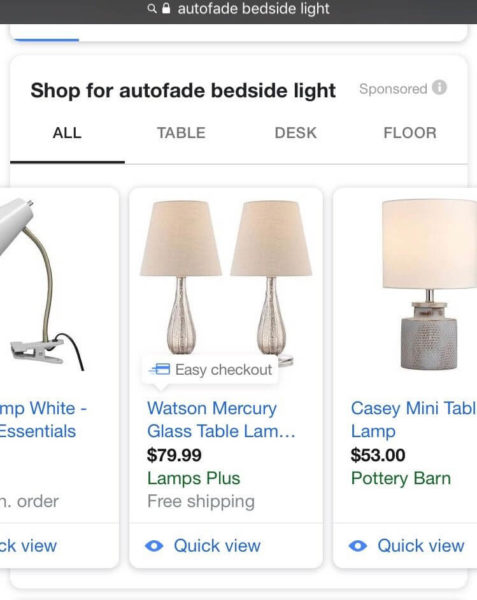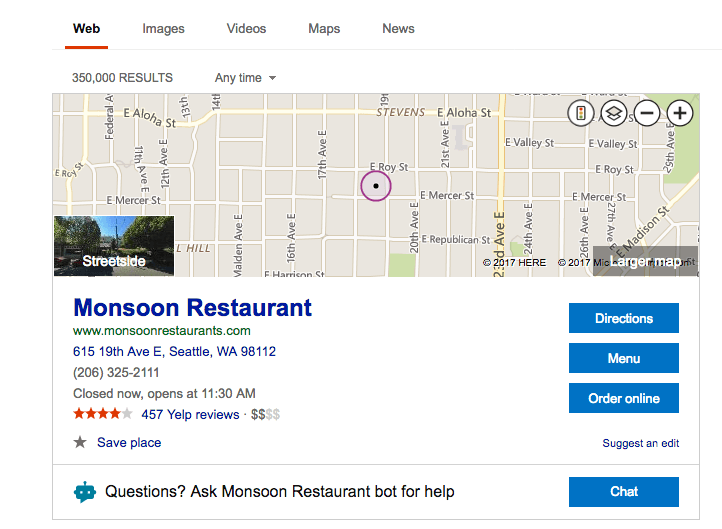PPC 2017: Epic review of the biggest trends & updates in paid search
This year, artificial intelligence and machine learning underpinned nearly every paid search update.
As 2017 draws to a close, let’s take a moment to catch our breaths and look back at the whirlwind that was PPC in 2017.
There wasn’t a big change that dominated the landscape like enhanced campaigns of 2013 or expanded text ads of 2016, but multiple trends created an atmosphere of constant, incremental change this year. However, if we were to dub 2017 the year of something in search marketing, it would clearly be the year of the machine. While machine learning and other forms of artificial intelligence aren’t new to search marketing, their use became pervasive in 2017.
Here’s a look back at the big developments and key trends that happened in PPC in 2017 that will continue to inform and influence our work in 2018.
Finally past the year of mobile, this was the year of AI in search
Sure, there is still work to do in improving mobile experiences and conversion rates, and we’ll continue to see Google, in particular, push its initiatives in this area: AMP for ads and landing pages, Purchases on Google and more. This year, the big shift was the extent to which machine learning and other forms of artificial intelligence permeated all things search.
Here are eight highlights of ways the search engines ingrained machine learning into their products. They cover everything from keyword matching to ads to audiences to spend pacing to attribution:
- In March, Google made putty of the meaning of ‘exact’ in exact match, stretching it to include close variants of a keyword with different word order and/or function words.
- Ad rank thresholds got a machine learning infusion to take the context of a query into consideration when setting the bid floor.
- Google’s Smart display campaigns are nearly entirely powered by machine learning.
- Google’s data-driven attribution methodology is entirely AI-powered. It’s been in AdWords for more than a year, but it gained new attention with the introduction to Google Attribution.
- Google and Bing released new automated bid strategies: Bing’s Maximize Clicks and Google’s Maximize Conversions.
- Google’s move to let daily spend exceed up to 2x the budget? Yep, that, too, relies on machine learning to try to predict spend trends throughout the month.
- One flavor of Google’s custom intent audiences on the GDN uses machine learning to automatically create audiences based in part on inferred characteristics of an advertiser’s target customers.
- Bing Ads is testing AI-powered chatbot extensions in search ads.
- Dynamic Search Ads in Bing Ads came to the US and the UK.
Forget A/B testing, because machine learning
Another big, if more subtle, shift was in ad testing methodology. All year, Google has pushed advertisers to move away from the A/B testing model of running two ads per ad group and manually assessing performance.
If there was any doubt Google was serious about this, the move to limit ad rotation options in August put that doubt to rest. The change makes the push for advertisers to choose “optimize,” letting the machines choose the best ad to serve, that much more forceful. Google’s Matt Lawson laid out in a column last month the argument for having at least three ads in an ad group: Overall impressions will increase as Google’s algorithms will serve up the best ad based on the specific query. Advertisers shouldn’t even be evaluating individual ad performance under this new rubric, but rather at the ad-group level of performance, says Google.
To this end, Google rebooted its Ads Added by AdWords pilot in September. The ads suggestions test automatically generates additional text ads (for approval) in some ad groups. Again, the goal is to get more advertisers running more ads in their ad groups, even if Google has to do the work for them.
[newsletter-form id=’6741’ text=’Get a daily dose of the latest Search news, tips and tactics. Sign up below.’]
Identity & audience targeting
Dovetailing with the rise of machine learning is the steady advance in audience targeting capabilities. Keyword intent may still be the calling card of search marketing, but audience targeting options continued to expand. The popularity of Facebook’s audience-focused, people-based marketing approach largely precipitated this shift over the years as Google has loosened the reigns on its user data and shifted to signed-in data for audience development and targeting.
Some of the big moves in audience targeting this year:
- Bing Ads began testing in-market and custom audiences at the beginning of the year. In September, it announced there are now more than 70 in-market audiences available to target.
- Google introduced in-market audiences and similar audiences to Search and Shopping campaigns in March, and consumer pattern targeting and life events targeting for YouTube and Gmail in May.
- Google’s custom intent audiences debuted in November for display campaigns.
- More offline data can now be used for first-party audience targeting as well. Earlier this month, Google expanded its Customer Match offering to include the ability to build retargeting lists based on customer phone numbers and addresses, not just email addresses.
- Microsoft has begun integrating the LinkedIn Graph with the Microsoft Audience Intelligence Graph. We should expect audience targeting to come out of this effort in 2018.
Attribution & 0nline-offline tracking
With more channels, more devices, more campaigns and more technology in play, attribution isn’t getting any easier. The biggest news on this front was, of course, the beta launch of Google Attribution. Announced in May, the product could upend the way many search marketers approach attribution, but the real impact won’t be seen until next year when the product rolls out more fully. Google Attribution aims to give users a bigger picture of how their channels and campaigns — at all stages of the funnel — are contributing to the bottom line.
The Google beauty of it is that the data can automatically feed back into AdWords or DoubleClick to inform bidding strategies. That’s the real motivation here; it’s not going to be the silver-bullet answer to everyone’s attribution challenges. From a Google campaign perspective, it will provide more cross-channel insights than AdWords or Google Analytics does currently.
The other big news in attribution this year largely revolved around online-to-offline conversions.
- Google’s in-store sales measurement news was the most notable. In one approach, retailers can upload their loyalty or other customer email lists into AdWords. The other approach is powered by Google partnerships with financial vendors. In-store sales conversions will automatically show up in AdWords when enough conversion data is available. Google has said its vendor-supported program gives it coverage of 70 percent of credit card transactions in the US.
- Google’s store visits measurement extended to YouTube campaigns as of May, giving retailers insights into how effective their videos are at driving viewers to stores.
- Bing’s support for uploading offline CRM conversion data with a new Offline Conversion Import tool in September.
- Bing’s integrations with call-tracking systems to enable call conversion imports rolled out this month.
Shopping keeps growing
Across the pond, Google got slapped with a giant antitrust fine by the EU for shutting competing comparison shopping engines (CSEs) out of Google Shopping. Google is contesting the fine, but in the meantime, Google Shopping is operating as a separate business unit and will compete in auctions against other CSEs for spots in the Shopping carousel in Google search results in the EU. (Crealytics’ Andreas Reifen and I each took issue with the ruling.)
Stateside, the influence of Shopping on retail search just continued to grow. At the year’s halfway mark, Merkle reported Google and Bing saw continued growth in shopping ad spend, outpacing that of text ads among retail clients. But there’s an elephant in the room, and its name is Amazon. Amazon loomed in terms of being a head-on competitor with its one-again-off-again presence in Google Shopping, in terms of the rapid and expanding build-out of ad offerings for merchants on its own site, as well as in the realm of product discovery and ordering via digital assistant.
For its part, Google continues to experiment with the way it displays shopping ads. Below is an example of an elusive Purchases on Google ad, but these ads also have a new “Quick view” feature that lets users learn more about the product and seller right from the search results.
Google continues to search for new places to extend Shopping ad inventory. At the end of May, it automatically opted advertisers into a test to show product ads on the Display Network.
Local, driven by mobile
Mobile, voice and digital assistants will continue to spur innovation next year, but perhaps in no area greater than local. Last year, Google said local searches are growing 50 percent faster than mobile search overall and account for one-third of mobile searches. Those habits are driving the development of search ad products aimed at connecting users to local businesses (thus the increase in online-to-offline attribution capabilities covered above). Merkle’s Andy Taylor covered the growing importance of local ad products for brick-and-mortar stores in his recent column.
- Though not ad-related, Bing launched bots for local businesses in Bing Places in May that also work with Facebook Messenger and Cortana.
- Google rebranded and expanded its ad products for local service providers. Local Services by Google will be in 30 cities as of year-end.
- Google teamed with HomeAdvisor and Porch to offer local services discovery and lead generation through Google Assistant and Google Home.
- Location extensions and store visits measurement extended to YouTube in October.
- Text ads and Local inventory ads (LIA) began showing in local knowledge panels in Google search results.
Honorable mentions
We can’t close out a 2017 wrap-up without mentioning the new AdWords interface. There is a lot of grumbling about the new UI, which is expected to become the de facto interface at some point in 2018. Change isn’t easy, and there still isn’t enough parity or ease of use to have endeared it to many paid search managers who are in it on a daily basis managing campaigns. But every sign indicates Google is leaning into this new “experience,” not backing away. There are many, many features now that are only available in the new UI. That will only continue.
In further evidence that 2017 was one long year, some updates that feel much older than they actually are. Can you believe Google switched to the green outline Ad Label this year (February)? All Mac users got access to Bing Ads Editor in March. Google added historical Quality Score data in AdWords in May. Oh, and AdWords price extensions rolled out to all devices in March, and Bing merchant promotions in Shopping ads came out of pilot in the US in April.
That does it for 2017. After I wrote this piece, I looked back at how I concluded 2016’s year-end wrap-up: “Expect to see the trends we saw this year — audiences; attribution, including online-to-offline; mobile; and automation — continuing to influence change in the year ahead.”
Looking at that list of trends in terms of next year, I’d swap out mobile for local (mobile is foundational now) and add voice marketing to the mix. We are still in very early days with voice and digital assistants in terms of marketing potential, but I expect we’ll continue to see this area develop rapidly.
Contributing authors are invited to create content for Search Engine Land and are chosen for their expertise and contribution to the search community. Our contributors work under the oversight of the editorial staff and contributions are checked for quality and relevance to our readers. The opinions they express are their own.
Related stories
New on Search Engine Land



